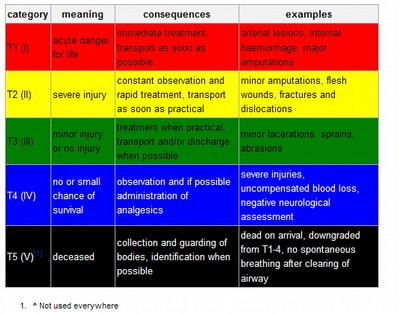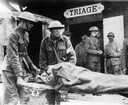Triage
Vadå Triage kanske ni undrar?. För så här är det och så gick det till att lördagen fick jag spendera mina dag på sjukhuset för att hjälpa pappa min som skada sig. Jag kan konstatera att det är farligt o klippa häck om man inte har koll på var man står o har sina ben. Som tur så slapp han och bli av med några fingrar men han skada sin hand rätt rejält ändån när han föll på marken.
Knappt en timma hemkommen så börja denna händelse. Det är så drygt komma till sjukhus. hur ofta har man inte drabbats av akutlång väntetid hos läkare o doktorer. sittklåda i gumpen, extrem väntrumsrastlöshet, men-va-fan-lång-tid-det-tar syndromet.
Ps: om du ska skada dej passa på o handla nån tidning eller ett par o ta med dej, allt från korsord till sudoku. Varför inte gameboy eller PSP för gamern, om du inte brutit tummarna dock.
Så det var på hospitalet jag stötte på Triage och här kommer förklaringen.
Triage är en process för att sortera och prioritera patienter så att de mest allvarliga eller brådskande fallen behandlas först.
Triage används både på akutmottagningar och på katastrofplatser. Ordet är bildat från franska trier, sortera.
Förklaring följer...
Simple triage:
is usually used in a scene of mass casualty, in order to sort patients into those who need critical attention and immediate transport to the hospital and those with less serious injuries. This step can be started before transportation becomes available. The categorization of patients based on the severity of their injuries can be aided with the use of printed triage tags or colored flagging.
S.T.A.R.T. (Simple Triage and Rapid Treatment) is a simple triage system that can be performed by lightly-trained lay and emergency personnel in emergencies.
Triage separates the injured into four groups:
1. The deceased who are beyond help
2. The injured who can be helped by immediate transportation
3. The injured whose transport can be delayed
4. Those with minor injuries, who need help less urgently
A simplified but effective description of the S.T.A.R.T. is taught in the Israeli army to non-medical personnel: the injured who are lying on the ground silently should be prepared for immediate transportation; injured lying on the ground but screaming are injured whose transportation can be delayed; and the walking wounded need help less urgently. Non-medical personnel have no authority to tag an injured person as deceased.
Advanced Triage system
Categories of severity In advanced triage systems, secondary triage is typically implemented by paramedics, battlefield medical personnel or by skilled nurses in the emergency departments of hospitals during disasters, injured people are sorted into five categories.
Black / Expectant They are so severely injured that they will die of their injuries, possibly in hours or days (large-body burns, severe trauma, lethal radiation dose), or in life-threatening medical crisis that they are unlikely to survive given the care available (cardiac arrest, septic shock, severe head or chest wounds); they should be taken to a holding area and given painkillers as required to reduce suffering.
Red / Immediate They require immediate surgery or other life-saving intervention, and have first priority for surgical teams or transport to advanced facilities; they "cannot wait" but are likely to survive with immediate treatment.
Yellow / Observation Their condition is stable for the moment but requires watching by trained persons and frequent re-triage, will need hospital care (and would receive immediate priority care under "normal" circumstances).
Green / Wait (walking wounded) They will require a doctor's care in several hours or days but not immediately, may wait for a number of hours or be told to go home and come back the next day (broken bones without compound fractures, many soft tissue injuries).
White / Dismiss (walking wounded) They have minor injuries; first aid and home care are sufficient, a doctor's care is not required. Injuries are along the lines of cuts and scrapes, or minor burns.
In addition to the standard practices of triage as mentioned above, there are conditions where sometimes the less wounded are treated in preference to the more severely wounded. This may arise in a situation such as war where the military setting may require soldiers be returned to combat as quickly as possible, or disaster situations where medical resources are limited in order to conserve resources for those likely to survive but requiring advanced medical care.
Det svenska Triage systemet liknar följande nedan:

Hur det hela börja
Triage originated and was first formalized in WWI by French doctors treating the battlefield wounded at the aid stations behind the front. Much is owed to the work of Dominique Jean Larrey during the Napoleonic Wars.
Historically, there has been a broad range of attempts to triage patients, and differing approaches and patient tagging systems used in a variety of different countries.
Triage has, in fact, existed for a very long time, without fancy names or pretty tags.
Until recently, triage results, whether performed by a paramedic or anyone else, were frequently a matter of the 'best guess', as opposed to any real or meaningful assessment.
In fact, triaging used to be taught with an emphasis on the speed of the function, rather than the accuracy of the outcome.
At its most primitive, those responsible for the removal of the wounded from a battlefield or their care afterwards have always divided victims into three basic categories:
1) Those who are likely to live, regardless of what care they receive;
2) Those who are likely to die, regardless of what care they receive;
3) Those for whom immediate care might make a positive difference in outcome.
Knappt en timma hemkommen så börja denna händelse. Det är så drygt komma till sjukhus. hur ofta har man inte drabbats av akutlång väntetid hos läkare o doktorer. sittklåda i gumpen, extrem väntrumsrastlöshet, men-va-fan-lång-tid-det-tar syndromet.
Ps: om du ska skada dej passa på o handla nån tidning eller ett par o ta med dej, allt från korsord till sudoku. Varför inte gameboy eller PSP för gamern, om du inte brutit tummarna dock.
Så det var på hospitalet jag stötte på Triage och här kommer förklaringen.
Triage är en process för att sortera och prioritera patienter så att de mest allvarliga eller brådskande fallen behandlas först.
Triage används både på akutmottagningar och på katastrofplatser. Ordet är bildat från franska trier, sortera.
Förklaring följer...
Simple triage:
is usually used in a scene of mass casualty, in order to sort patients into those who need critical attention and immediate transport to the hospital and those with less serious injuries. This step can be started before transportation becomes available. The categorization of patients based on the severity of their injuries can be aided with the use of printed triage tags or colored flagging.
S.T.A.R.T. (Simple Triage and Rapid Treatment) is a simple triage system that can be performed by lightly-trained lay and emergency personnel in emergencies.
Triage separates the injured into four groups:
1. The deceased who are beyond help
2. The injured who can be helped by immediate transportation
3. The injured whose transport can be delayed
4. Those with minor injuries, who need help less urgently
A simplified but effective description of the S.T.A.R.T. is taught in the Israeli army to non-medical personnel: the injured who are lying on the ground silently should be prepared for immediate transportation; injured lying on the ground but screaming are injured whose transportation can be delayed; and the walking wounded need help less urgently. Non-medical personnel have no authority to tag an injured person as deceased.
Advanced Triage system
Categories of severity In advanced triage systems, secondary triage is typically implemented by paramedics, battlefield medical personnel or by skilled nurses in the emergency departments of hospitals during disasters, injured people are sorted into five categories.
Black / Expectant They are so severely injured that they will die of their injuries, possibly in hours or days (large-body burns, severe trauma, lethal radiation dose), or in life-threatening medical crisis that they are unlikely to survive given the care available (cardiac arrest, septic shock, severe head or chest wounds); they should be taken to a holding area and given painkillers as required to reduce suffering.
Red / Immediate They require immediate surgery or other life-saving intervention, and have first priority for surgical teams or transport to advanced facilities; they "cannot wait" but are likely to survive with immediate treatment.
Yellow / Observation Their condition is stable for the moment but requires watching by trained persons and frequent re-triage, will need hospital care (and would receive immediate priority care under "normal" circumstances).
Green / Wait (walking wounded) They will require a doctor's care in several hours or days but not immediately, may wait for a number of hours or be told to go home and come back the next day (broken bones without compound fractures, many soft tissue injuries).
White / Dismiss (walking wounded) They have minor injuries; first aid and home care are sufficient, a doctor's care is not required. Injuries are along the lines of cuts and scrapes, or minor burns.
In addition to the standard practices of triage as mentioned above, there are conditions where sometimes the less wounded are treated in preference to the more severely wounded. This may arise in a situation such as war where the military setting may require soldiers be returned to combat as quickly as possible, or disaster situations where medical resources are limited in order to conserve resources for those likely to survive but requiring advanced medical care.
Det svenska Triage systemet liknar följande nedan:

Hur det hela börja
Triage originated and was first formalized in WWI by French doctors treating the battlefield wounded at the aid stations behind the front. Much is owed to the work of Dominique Jean Larrey during the Napoleonic Wars.
Historically, there has been a broad range of attempts to triage patients, and differing approaches and patient tagging systems used in a variety of different countries.
Triage has, in fact, existed for a very long time, without fancy names or pretty tags.
Until recently, triage results, whether performed by a paramedic or anyone else, were frequently a matter of the 'best guess', as opposed to any real or meaningful assessment.
In fact, triaging used to be taught with an emphasis on the speed of the function, rather than the accuracy of the outcome.
At its most primitive, those responsible for the removal of the wounded from a battlefield or their care afterwards have always divided victims into three basic categories:
1) Those who are likely to live, regardless of what care they receive;
2) Those who are likely to die, regardless of what care they receive;
3) Those for whom immediate care might make a positive difference in outcome.
Kommentarer
Trackback



